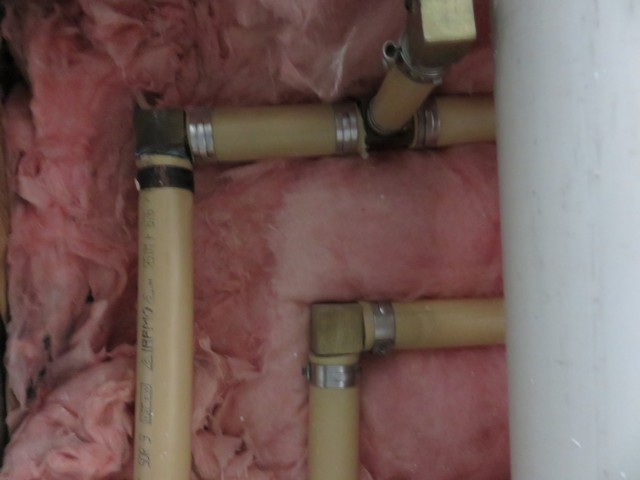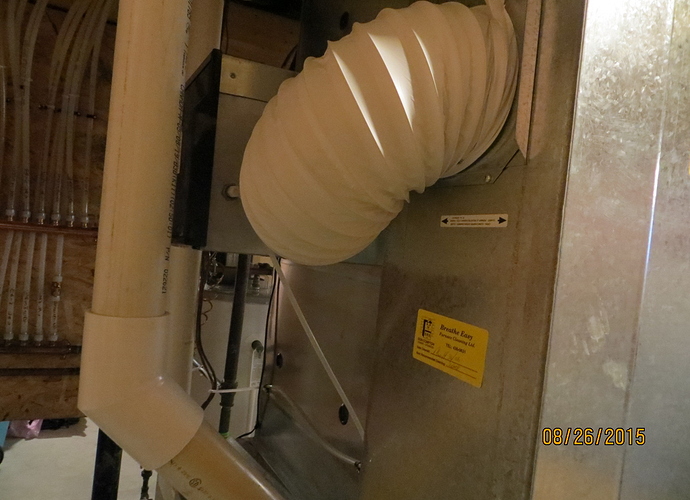Here are a couple of pictures of a Electric furnace that I inspected. It is an Electric forced air furnace with electric heat coils and a forced air central air unit. This unit is in a Manufactured home so there is no cold air return ducting, instead all cold air is returned through vents above all doorways and through vented doors in this closet. I noted some rusting on the A Coil probably just due to age but worth noting.
The system that I inspected is a electric forced air furnace with a forced air split A/C unit. The system is around 10 years old and shows some cosmetic aging, as in surface rust on both the “A” coil and on the condensing unit outside but the system is still functional. The thermostat for the system is located in the living room of the residence. There was a new filter installed on the furnace and the condensing unit was free of debris and vegetation and there is a electrical disconnect locate next to the unit outside.
I read the article “Identifying Furnaces”. It is important to understand what type of furnace we are looking at in order to accurately convey the type and condition to the home owner or home buyer.
Very interesting information…I enjoy this course.
I’m in process of taking the HVAC course. Looks great so far.
This is an unusual defect found in a 2 year old condenser (outside) unit. My initial suspicion was a manufacturing defect due to the age of the unit - 2012 and the localized region of corrosion. I have seen corrosion like this on 25 year old units, but never one so “new”, and rarely confined to a specific area. A bit of research has me convinced that the cause was dog urine. Apparently it will react with the metals and is very corrosive. It turns out the owner has two large german sheppards that have full run of the backyard - where the unit was installed.
“Write a Report” Section of this HVAC course.
I downloaded the provided report checklist and inspected the exterior AC unit as well as the forced air gas furnace. All checked out with the exception of a very dirty filter that would possibly limit air flow. This in turn could contribute to overheating internal components of the furnace (heat exchangers etc) as well as reduce efficiency of both heating and cooling. Recommend change filter NOW and check monthly.
Assignment HVAC course: Online Library HVAC
Homeowner Maintenance: Changing the HVAC filter.
This article was helpful for me in that I think just about every client asks “How often should I change the filter?”
My reply so far has typically related to alergens, mold etc and sensitivity of the occupants. I had not considered the effect poor or restricted airflow might have on furnace components. A further take-away from the course: I also had no idea that an electronic air filter can be 8 or 9 times more effective at cleaning air.
Great information!
The photo shows an evaporator that caught fire from a malfuctioning ciruit board. Watch out for those cheap Chinese made mini-splits.

I just read the article titled Inspecting Furnaces in the Inspection Articles Library. Great article. We should be able to describe the furnace by fuel type, distribution, flow and efficiency. Is it a forced air distribution system or a gravity system? This may be a good question to ask if the unit is centrally located in a basement. Does the system have a standing pilot, intermittent pilot or direct spark, or a hot surface igniter? Answering this question may help you determine the furnace’s efficiency. These are questions I am thinking of to help me conduct my inspections just from reading this article.

I am taking this course now but, I am an AC Tech. This ac unit is from an Inspection I did yesterday. I don’t have any questions so far 
Polybutylene for Inspectors
Polybutylene is a plastic manufactured between 1978 and mid-1995 for use as piping in home plumbing systems. It was cheap and offered plenty of advantages over the other materials. Polybutylene pipes were rupturing and causing a lot property damage. In the homes that still contain this material, homeowners must pay to have the pipes replaced or risk not getting home owner’s insurance. In Florida, most Insurance carriers will not insure a house with Polybutylene or PEX piping. Polybutylene Pipes Should Be Replaced. Just did a Home Inspection on a 1998 Town House that has Polybutylene, needless to say the buyer backed out
http://www.nachi.org/forum/attachment.php?attachmentid=100275&stc=1&d=1440629749.

Pricing and Billing for Home Inspectors
How much should we charge for our services. We need to learn to set competitive prices
Pricing
Your hourly rate needs to cover not just your time, but also your overhead. And let’s not forget profits.
Billable Hours
The billable hours depends on how long it takes you to complete an Inspection.
This is a picture of a gas furnace and two gas water heaters with plenum duct work. No, the dryer next to it is not hooked up.
Here are 2 photos of the Furnace Humidifier and Hot Water Heater
I checked and replaced the Furnace disposable filter only yesterday ( last change May 2014 !!) and it was really dirty and should have been replaced earlier.
WH
I uploaded two pictures for the Share an Image Requirement. They go hand in hand with each other. Picture one is of an oil fired furnace located in the basement of a residence. As you can see in the picture, the furnace is almost against the concrete wall. The second picture is manufacture sticker on the furnace which clearly states at the bottom to provide access to service all components. The components on the back can not be reached without moving furnace.
For the Write a Report requirement of this course I inspected my own HVAC system using the Inspection Check list. It was inspected to the InterNACHI SOP. The HVAC is a split system whose heat conveying medium is forced air. There is a gas fuel furnace in the attic for heat in the winter. Also in the attic is the evaporator coil for the cooling system. Outside is the electric power cooling unit which consists of a condenser and compressor. Both the unit in the attic and outside have electrical disconnects within sight of the unit. The heating unit has a gas cut off on the supply line to the unit for quick access. The heating unit is vented through a metal flue which exits the roof. The closest flammable material to the flue is 6"inches. The thermostat was located on the hallway wall below the cold air return. The filter was clean and was 20X25.
As a requirement for this training course, I have chosen to upload my image showing dirty cooling fins on an exterior AC unit. Living here in SD, it’s windy 8 days per week, and nearly every unit is caked full of dirt, cotton, and other debris. I believe it’s a forgotten part of standard home maintenance, and I always make sure to remind my client that hosing these fins off will make their unit run more efficiently.
Hi
Pls find attached my Home HVAC Inspection Report
Regards
Waiel









